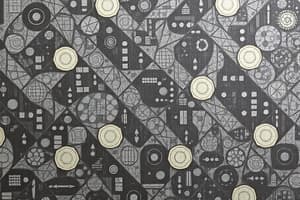Podcast
Questions and Answers
What type of sequence involves a constant difference between consecutive terms?
What type of sequence involves a constant difference between consecutive terms?
- Recursive sequence
- Fibonacci sequence
- Geometric sequence
- Arithmetic sequence (correct)
Which type of sequence has a constant ratio between successive terms?
Which type of sequence has a constant ratio between successive terms?
- Pattern recognition sequence
- Arithmetic sequence
- Geometric sequence (correct)
- Recursive sequence
What role does pattern recognition play in mathematics?
What role does pattern recognition play in mathematics?
- It helps identify underlying structures or relationships in data. (correct)
- It calculates the common differences in arithmetic sequences.
- It determines the explicit form of geometric sequences.
- It simplifies the recursive form of sequences.
In an arithmetic sequence, what does the common difference represent?
In an arithmetic sequence, what does the common difference represent?
Which kind of sequence can be defined by adding a fixed amount to the previous term for each new term?
Which kind of sequence can be defined by adding a fixed amount to the previous term for each new term?
What operation is primarily involved in obtaining each new term in a geometric sequence?
What operation is primarily involved in obtaining each new term in a geometric sequence?
Which type of sequence involves construction of new terms based on a recurrence relation to earlier terms?
Which type of sequence involves construction of new terms based on a recurrence relation to earlier terms?
In a recursive sequence, what is the relationship between consecutive terms in the Fibonacci sequence?
In a recursive sequence, what is the relationship between consecutive terms in the Fibonacci sequence?
Which formula can be used to calculate the nth term of a geometric sequence with a common ratio r?
Which formula can be used to calculate the nth term of a geometric sequence with a common ratio r?
What is the constant value that the ratio between consecutive terms in the Fibonacci sequence approaches?
What is the constant value that the ratio between consecutive terms in the Fibonacci sequence approaches?
Flashcards are hidden until you start studying
Study Notes
Patterns and Sequences
Arithmetic Sequences
An arithmetic sequence is a type of sequence where the difference between consecutive terms remains constant. In such a sequence, the gap between every pair of adjacent numbers is the same. Arithmetic sequences can be represented in either the explicit form or the recursive form. The explicit form of an arithmetic sequence involves writing down the general term in terms of index i, whereas the recursive form states that each term can be computed by adding a fixed amount to the previous term. The common difference d represents the constant gap between each term in an arithmetic sequence.
For example, consider the sequence 4, 5, 6, 7, 8, 9. Here, the common difference is 1. The general term for the nth term in this sequence is given by an = 4 + (n-1).
Pattern Recognition
Pattern recognition refers to the ability to discern underlying structures or relationships between elements of a set of data. It plays a crucial role in mathematics, particularly in analyzing and understanding different types of sequences. By identifying patterns, mathematicians can make predictions about future outcomes or behaviors based on existing trends.
Geometric Sequences
A geometric sequence is another type of sequence where the ratio or proportion between consecutive terms remains constant. In other words, the ratio between successive terms is constant throughout the entire sequence. Unlike arithmetic sequences, geometric sequences involve multiplication rather than addition to obtain each new term from the previous one. Just like arithmetic sequences, geometric sequences can be expressed in either an explicit form or a recursive form.
If a1 is the first term and r is the common ratio, then the nth term of a geometric sequence can be calculated as ar^(n-1).
Recursive Sequences
A recursive sequence is a mathematical concept where each term in the sequence depends on the previous ones. Recursive sequences follow a rule where later terms are constructed through the application of a recurrence relation to earlier terms. These sequences are typically presented in the form of recurrence relations, which provide a step-by-step procedure for computing the new terms based on the previously known ones.
Consider the sequence 0, 1, 1, 2, 3, 5, 8, 13, 21, ..., where each subsequent term is obtained by summing the two preceding terms. This is an example of a recursive sequence.
Fibonacci Sequence
The Fibonacci sequence is a famous example of another type of recursive sequence, where the ratio between consecutive terms approaches a constant value known as the golden ratio ϕ (approximately equal to 1.618033988749895). The Fibonacci sequence starts with 0, 1, 1, 2, 3, 5, 8, 13, 21, ..., where subsequent terms are obtained by adding the two preceding ones.
The recursive formula for the nth Fibonacci number Fn can be expressed as:
Fn = Fn-1 + Fn-2
Using these concepts, it is possible to generate an infinite variety of sequences that exhibit interesting mathematical properties and relationships. Patterns and sequences continue to be studied thoroughly due to their extensive applicabilities in various fields of mathematics and science.
Studying That Suits You
Use AI to generate personalized quizzes and flashcards to suit your learning preferences.




